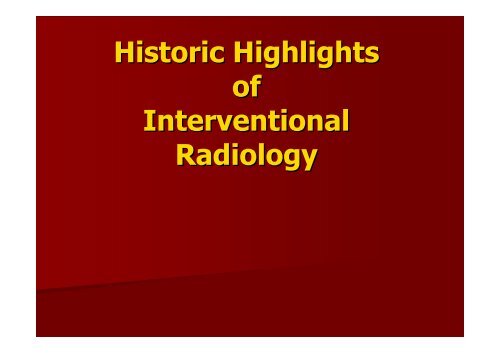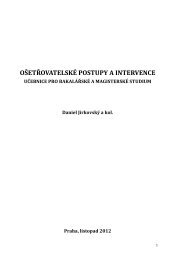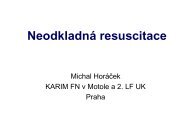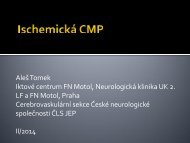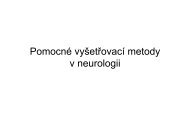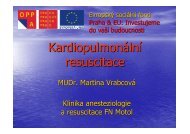Vascular intervention
Vascular intervention
Vascular intervention
You also want an ePaper? Increase the reach of your titles
YUMPU automatically turns print PDFs into web optimized ePapers that Google loves.
Historic Highlights<br />
of<br />
Interventional<br />
Radiology
INTERVENTION RADIOLOGY<br />
<strong>Vascular</strong> <strong>intervention</strong><br />
Nonvascular <strong>intervention</strong><br />
- important to establish a good<br />
radiologist/patient relationship<br />
and to obtain informed consent
Father of<br />
IR<br />
PTA
Cardiac<br />
catheterization<br />
and angiographic<br />
techniques<br />
of<br />
future
“A A cardiac catheter can be more than a<br />
tool for passive means for diagnostic<br />
observation; used with imagination it<br />
can become an important surgical<br />
instrument”.<br />
June 1963
Catheters should<br />
replace scalpels
June 1963
5oth year anniversary of Congressus<br />
Radiologicus Cechoslovacus<br />
1963-2013<br />
Planting the seeds of Interventional Radiology<br />
by Charles T Dotter
INTERVENTION RADIOLOGY<br />
The procedure should be undertaken only<br />
if there is a clear clinical indication<br />
Any procedure should d be in the best<br />
interest of the patient<br />
The potential benefits of the procedure<br />
should d outweigh the risk
Analgesia and Sedatio<br />
Interventional techniques require patient<br />
co-operation.<br />
operation.<br />
The patient must be comfortable and pain<br />
free.<br />
The vast majority of work involves – sedation<br />
and analgesic techniques.
Interventional Suit Design
Following the procedure the patients<br />
recovery suite<br />
day ward
1953 I Seldiger: : Percutaneous<br />
catheterization<br />
1964 C Dotter: SFA recanalization<br />
(coaxial catheters)<br />
1974 A Grüntzig: Balloon catheter PTA
PTA<br />
- percutaneous transluminal angioplasty<br />
PTA increases the luminal diameter of a<br />
stenotic artery by causing plaque fracture,<br />
often with accompanying local intima-<br />
medial dissection.
January 16, 1964
Catheter therapy<br />
“Transluminal angioplasty”<br />
was born<br />
January 16, 1964
Balloon Angioplasty<br />
1975<br />
A. Grüntzig
PTA Mechanism<br />
Vessel wall permanent „overstretching“<br />
Plaque remodelation/compression<br />
Intima/medie controlable<br />
dissection/rupture
PTA<br />
Indications (extremity PTA)<br />
1. Lifestyle-limiting limiting claudication.<br />
2. Critical ischemia (rest pain, ulcer, gangrene).<br />
3. To increase inflow or outflow prior to or after<br />
bypass surgery.<br />
4. Bypass graft stenosis.<br />
The balloon diameter should be equal to the adjacent<br />
normal vessel diameter.
PTA<br />
Contraindications (extremity PTA)<br />
Absolute<br />
1. Patient is medically unstable.<br />
2. Stenosis is not hemodynamically significant.<br />
3. Stenosis is immediately adjacent to an<br />
aneurysm.<br />
4. Ulcerative disease with evidence of distal<br />
embolization is present.
Team cooperation<br />
angiologist<br />
vascular surgeon<br />
<strong>intervention</strong>al radiologist
STENTS<br />
•balloon-expandable<br />
•self-expandableexpandable<br />
Aim of stent implantation is to keep<br />
arterial lumen widely open with smooth<br />
surface. It prevents „recoil“,, but it does<br />
not prevent intimal hyperplasia or<br />
atherosclerosis progression.
Stent Design<br />
Stents (a form of scaffolding used to contain and reinforce the<br />
patency of a biological conduit)<br />
<br />
<br />
– plastic (hepatobiliary, urinary<br />
system)<br />
– metal (stainless steel, nitinol)<br />
balloon expandable<br />
self-expanding<br />
expanding<br />
(problems – thrombosis, intimal hyperplasia)
alloon-expandable<br />
stents
Balloon Expandable Stent<br />
1985<br />
J. Palmaz
Expandable Nitinol Coil Stent<br />
1983<br />
C. Dotter
Self-Expanding Medinvent Stent<br />
1985<br />
H. Wallsten<br />
Wallstent
Categories of catheter-<br />
based tools<br />
Access needles<br />
18-gauge<br />
21-gauge micro-puncture kit<br />
Sheats-4 4 Fr and greater<br />
Short straight (10-12 12 cm and 22-25 25 cm lengths)<br />
Long straight (90cm)<br />
Preshaped crossover sheaths (45-60)
Categories of catheter-<br />
based tools<br />
Wires-0.014 to 0.035 inches diameter (regular and exchange-<br />
lenght)<br />
Hydrophilic (e.g.glide wire)<br />
Nonhydrophilic (i.e., working wires)<br />
Starter (e.g., starter J-wire J<br />
or Bentson wire)<br />
Stiff (e.g., Amplatz, Cook, Inc., Bloomington, IN)<br />
Catheters<br />
Nonselective flush (e.g., straight, pigtail, Omni)<br />
Selective/end hole (e.g., angled glide, Bernstein, Cobra,<br />
Simmons)<br />
Infusion (e.g., multiside hole thrombolytic)<br />
Guide Catheters
Categories of catheter-<br />
based tools<br />
Balloons<br />
Compliant<br />
Noncompliant<br />
Cutting<br />
Cryo-balloons<br />
Stents<br />
Balloon-expandable<br />
Self-expanding<br />
expanding<br />
Coreved (i.e., stent grafts)<br />
Intravascular ultrasound (IVUS)<br />
Mechanical thrombolysis (e.g., Angiojet, Possis Medical, Minneapolis, MN<br />
Access or puncture site closure devices<br />
e.g., Angiojet, Possis Medical, Minneapolis, MN)
Levels of clinical evidence and<br />
Levels<br />
classification of<br />
recommendations<br />
Level A Evidence from multiple randomized trials or meta-analyses<br />
analyses<br />
Level B Evidence from single randomized trial or nonrandomized<br />
studies<br />
Level C Evidence from retrospective or case studies or case studies or<br />
from expert opinion
Levels of clinical evidence and<br />
Classification<br />
classification of<br />
recommendations<br />
Class I Treatment or procedur eis useful or effective (i.e., benefit far<br />
outweighas the risk and treatment should be performed)<br />
Class IIa<br />
Recommendation in favor or treatment or procedure<br />
being useful or effective (i.e., benefit outweighs the risk and it is<br />
reasonable to perform treatment)<br />
Class IIb<br />
Usefulness or effectiveness leas well established (i.e.,<br />
benefit is equal to or greater than the risk and the procedure or o<br />
treatment may be considered)<br />
Class III<br />
Treatment or procedur eis not useful and may be<br />
harmful (i.e., risk outweighs the benefits and treatment should not<br />
be performed)
Categories of chronic limb<br />
ischemia<br />
Grade Category Clinical description Objective criteria<br />
0 0 Asymptomatic-no<br />
significant occlusive<br />
disease<br />
Normal treadmill/stress test<br />
1 Mild claudication Complete treadmill test; AP<br />
after test >50 mm Hg<br />
I 2 Moderate claudication Between categories 1 and 3<br />
3 Severe claudication Cannot complete treadmill<br />
test; AP after test
Categories of chronic limb<br />
ischemia<br />
Grade Category Clinical description Objective criteria<br />
II 4 Ischemia rest pain Resting AP
11,3 mm<br />
10,7 mm
ILIAC ARTERIES<br />
Indications: stenoses < 10 cm,<br />
occlusions < 5 cm<br />
Technical success rate > 95 %<br />
Primary patency rate (4 years FU) ><br />
75 %<br />
Complications < 5 %<br />
Routine procedure, thousands of patients followed<br />
up.
ILIAC ARTERIES<br />
PTA vs Surgery<br />
↓long-term patency ↑complications<br />
(mortality 2-72<br />
7 %)<br />
↓hospital stay ↑recovery<br />
price
Stent EXPRESS<br />
<strong>Vascular</strong> LD<br />
9 mm x 37 mm<br />
Stent EXPRESS<br />
<strong>Vascular</strong> LD<br />
8 mm x 37 mm
FEMOROPOPLITEAL ARTERIES<br />
Indications: stenoses/occlusions < 5-<br />
10cm<br />
Technical success rate > 90 %<br />
Primary patency (4years FU) 45-50 50 %<br />
Complications 5-85<br />
8 %<br />
Negative preventing factors: lesions over 10 cm,<br />
calcifications, artery diameter < 5 mm, poor run-<br />
off.<br />
Routine procedure, thousands of patients followed-<br />
up.
FEMOROPOPLITEAL<br />
ARTERIES<br />
PTA vs Surgery<br />
↓long-term patency ↑complications<br />
↓hospital stay ↑recovery<br />
price
FEMOROPOPLITEAL<br />
ARTERIES<br />
PTA vs Surgery<br />
↓long-term patency ↑complications<br />
↓hospital stay ↑recovery<br />
price
INFRAPOPLITEAL ARTERIES<br />
PTA not generally accepted as a<br />
method of first choice<br />
Technical success rate > 90 % in<br />
selected patients<br />
Two-years limb salvage 70 % (!<br />
Does not correspond to the<br />
patency rate!)<br />
Publications: tens to hundreds of patients
INFRAPOPLITEAL<br />
ARTERIES<br />
PTA vs Surgery<br />
No data available. PTA sometimes<br />
performed in patients who are not suitable<br />
candidates for surgery, or one method may<br />
support the other. Expensive, but<br />
potentially limb salvaging procedure.
PTA OF LOWER LIMBS ARTERIES<br />
Accepted method of arterial occlusive<br />
disease treatment.<br />
It should be performed by well<br />
trained specialists in dedicated cath-<br />
labs.<br />
It should not compete with vascular<br />
surgery, but should be it‘s s partner.
COMBINATION OF<br />
FEMOROPOPLITEAL<br />
BYPASS AND<br />
INFRAPOPLITEAL PTA IN<br />
PATIENTS WITH<br />
CRITICAL LOWER LIMB<br />
ISCHEMIA
Infrapopliteal PTA<br />
Take home points<br />
Long and expensive procedure<br />
If successful, it can help to jeopardised<br />
limb salvage<br />
In some cases even partial<br />
revascularization can remove the<br />
symptoms<br />
Long-term patency unknown<br />
Long-term limb salvage 50 – 70 %
IKEM clinical c<br />
follow ow up<br />
No.of limbs followed<br />
L.salvage(secondary)<br />
1 year 469 380 81 %<br />
2 years 300 237 79 %<br />
3 years 184 140 76 %<br />
4 years 123 91 74 %<br />
5 years 78 55 71 %
Subintimal recanalization<br />
• Long occlusion<br />
(>10 cm)<br />
• Reentry 90 %.<br />
(A. Bolia, 1990 )
Case – SIR AFS + a. fibularis, ipsilateral access<br />
• 76-y.o, 7 years after FP BP, rest pain
5 mm 6 mm
CTA za 12 měsíců
CTA za 12 měsíců
CTA after 1 y
OUTBACK® LTD<br />
Re-Entry Catheter<br />
Cordis - 6, 5 F
PTRA<br />
Aim: to open stenotic/ occluded renal artery<br />
without causing any harm to the<br />
kidney perfusion and function.<br />
The effect of PTRA should be permanent.
PTRA: Approach<br />
Femoral artery most frequently used.<br />
Ipsilateral femoral artery preferred.
STENT IMPLANTATION<br />
● PTRA complication/failure<br />
● Occluded RA recanalization<br />
● Ostial RA stenosis<br />
● Asymmetric/ ulcerated stenosis<br />
● Solitary kidney
Stentgraft
Stentgraft<br />
A/V shunt pseudoaneurysm aneurysm
Aortic Stentgraft Follow-up
Type B aortic dissection
Enlargement of landing zones<br />
Hybrid repair: extended the limits of EVAR<br />
extra-anatomic rerouting or debranching procedure
Stentgraft
Stentgraft
Stentgraft
Catheter-directed<br />
thrombolysis<br />
A catheter is inserted and used to deliver<br />
the lytic agent directly into the thrombus,<br />
thus greatly improving the efficiency of<br />
clot lysis and provides access for<br />
adjunctive techniques such as angioplasty<br />
and stent placement.
Catheter-directed<br />
thrombolysis
Peripheral Arterial Interventions<br />
= thrombolysis as the only option of<br />
primary treatment<br />
– pacients s with complete outflow tract<br />
occlusion<br />
– pacients with acute myocardial<br />
infarction
Acute critical ischemia<br />
<br />
percutaneous aspiration embolectomy
Acute critical ischemia<br />
local thrombolytic<br />
therapy<br />
(accelerated form)
Pulse-spray pharmacomechanical<br />
thrombolysis<br />
22 mg rt-PA
Acute critical ischemia<br />
thrombolysis as the only option of primary treatment<br />
– pacient<br />
with complete outflow tract occlusion
Pulse-spray pharmacomechanical<br />
thrombolysis
20 mg rt-PA
Acute critical ischemia<br />
thrombolysis + PTA
20 mg rt-PA
veckebauer4bo<br />
veckebauer4co
Acute critical ischemia<br />
thrombolysis + surgery
48 mg rt-PA
TREATMENT OF VENOUS<br />
THROMBOSIS
Deep vein thrombosis<br />
= DVT<br />
DVT is serious and potentially life<br />
threatening disease, often resulting<br />
in complications such as pulmonary<br />
embolism, phlegmasia cerulea dolens,<br />
and post-thrombotic syndrome.
DVT<br />
Risk factors:<br />
1. Surgery, esp. on legs / pelvis (orthopedic)<br />
2. Severe trauma<br />
3. Prolonged immobilization<br />
4. Malignancy<br />
5. Obesity<br />
6. Diabetes<br />
7. Pregnancy and for 8 – 12 weeks postpartum
DVT<br />
Risk factors:<br />
8. Oral contraceptives<br />
9. Decreased cardiac function<br />
10. Age > 40 years<br />
11. Varicose veins<br />
12. Previous DVT<br />
13. Patients with blood group A > blood group O<br />
14. Polycythemia<br />
15. Smoking
DVT<br />
Localization:<br />
1. Dorsal calf veins<br />
(± ascending thrombosis)<br />
2. Iliofemoral veins<br />
(± descending thrombosis)<br />
3. Peripheral + iliofemoral veins simultaneously
Diagnosis of suspected (symptomatic)<br />
acute DVT<br />
• Local symptoms due to obstruction<br />
(warmth, swelling, blanching of skin / blue leg, pain)<br />
• Duplex US or IPG<br />
• Venography or MRV (CTV)
Venous <strong>intervention</strong>s<br />
Acute<br />
OCCLUSION<br />
Chronic
Therapy of DVT<br />
• Standard heparin therapy<br />
• Systemic thrombolysis<br />
• Surgical thrombectomy<br />
• Catheter-directed thrombolysis<br />
• Percutaneous mechanical thrombectomy<br />
• Combination of more techniques
Heparin therapy<br />
Only 10% of patients have spontaneous<br />
lysis of their DVT within 10 days of<br />
heparin therapy, and up to 40% of patients<br />
continue to have propagation of thrombus<br />
despite treatment with heparin.<br />
(Sherry S. Semin Intervent Radiol 4:331-337, 1985)<br />
(Krupski WC, et al. J Vasc Surg 12:467-475, 1990)
Thrombolytic therapy<br />
The resulting benefits would be expected to include:<br />
1) improved if not normalized venous circulatory<br />
hemodynamics,<br />
2) decreased circulatory burden on the superficial<br />
venous system with reduced varix formation,<br />
3) decreased collateral formation,<br />
4) reduced damage to the venous valves.<br />
(Savader SJ: Peripheral and central deep venous thrombosis. In Savader S, Trerotola SO<br />
(eds): Venous <strong>intervention</strong>al radiology with clinical perspectives. New York,Thieme<br />
Medical Publishers, 1996)
DVT<br />
Indication<br />
1) Symptomatic iliofemoral thrombosis<br />
(≤ 10 days)<br />
2) Phlegmasia cerulea dolens
Catheter-directed thrombolysis for<br />
lower extremity DVT: Report of a<br />
national multicenter registry<br />
Mewissen MW, Seabrook GR, Meissner MH, et al. Radiology 211:39-49, 1999.<br />
The Venous Registry described treatment of 303 limbs in 287<br />
patients with acute and chronic lower extremity DVT treated with<br />
urokinase (mean, 7.8 million U and 53.4 hours), the overall complete<br />
and partial lysis rate was 83% with a 1-year patency rate of 60%.<br />
Patients with complete lysis had higher 1-year patency rate (79%).<br />
Iliofemoral thromboses fared significantly better than<br />
femoropopliteal thromboses (no iliac involvement) with 1-year<br />
patency rates of 79% and 64%, respectively.
Catheter-directed thrombolysis for<br />
lower extremity DVT: Report of a<br />
national multicenter registry<br />
Mewissen MW, Seabrook GR, Meissner MH, et al. Radiology 211:39-49, 1999.<br />
Complications<br />
Major bleeding ……………………….. 54 (11%) pts<br />
Pulmonary embolism ……………….. 6 (1%) pts<br />
Deaths …………………………………. 2 (
Catheter-directed<br />
thrombolysis<br />
A catheter is inserted and used to deliver<br />
the lytic agent directly into the thrombus,<br />
thus greatly improving the efficiency of<br />
clot lysis and provides venous access for<br />
adjunctive techniques such as angioplasty<br />
and stent placement.
Recommendations for catheterdirect<br />
infusion rt-PA (Alteplase)<br />
(Actilyse; Boehringer Ingelheim Pharma KG, SRN)<br />
1) 0.5 →1.0 mg/h (0.12 → 2.0 mg/h)<br />
2) Total dose should not exceed 20 - 40 mg<br />
3) Delivery (pulsed spray vs. drip infusion) not crucial<br />
4) Concomitant heparin: 500 IU/h; PTT: 1.25 - 1.5 times<br />
control<br />
(Mazer MJ. Thrombolysis: Venous. Eds. Workshop Handout Book. Fairfax, VA:<br />
SCVIR, 2001; 585-606)
Inferior vena cava filters<br />
1. Free floating iliofemoral or IVC<br />
thrombus<br />
2. Recurrent PE despite adequate<br />
anticoagulation<br />
3. Mechanical thrombectomy
Catheter-directed thrombolysis<br />
Approach<br />
• Ipsilateral popliteal vein<br />
(posterior tibial vein, dual crossed popliteal vein<br />
access)<br />
• Internal jugular vein<br />
• Contralateral femoral vein
Case<br />
• 25 y.o. female<br />
• 11 days history of right l. limb edema<br />
• Oral contraceptives
43 mg rt-PA
Pulsed - spray technique<br />
(rt-PA)<br />
• 0.5 ml pulsed every 90 seconds<br />
• 0.5 ml pulsed every 3 minutes<br />
• 0.5 ml pulsed every 6 minutes<br />
= 2.0 mg/h<br />
= 1.0 mg/h<br />
= 0.5 mg/h<br />
(Mazer MJ. Thrombolysis: Venous. Eds. Workshop Handout Book.<br />
Fairfax, VA: SCVIR, 2001; 585-606)<br />
• pulse spray injector can be used
56 mg rt-PA
MRV follow-up 12 months
Following therapy<br />
• LMWH<br />
• Warfarin (INR 2 – 3, for 6 months)<br />
• Venous compression stocking
Percutaneous mechanical<br />
thrombectomy/ thrombolysis<br />
(PMT)<br />
Advantages<br />
1. Immediate clot removal with restoration<br />
of improved circulatory hemodynamics<br />
2. Rapid resolution of venous thrombosis in<br />
minutes<br />
3. Reduced expense versus thrombolytic or<br />
surgical thrombectomy<br />
4. Decreased room time versus thrombolytic<br />
therapy without the need for multiple<br />
follow-up venograms
Mechanical devices
Rotarex - fragmentation
Case<br />
• 26 y.o. female<br />
• Acute (7 days) history of left l. limb edema<br />
• Oral contraceptives
Cavography<br />
Left iliofemoral<br />
thrombosis<br />
24 mm<br />
IVC calibration
Filter insertion<br />
9 mm PTD<br />
(2 passes)
Procedure pics
15 mm PTD<br />
(5 passes)<br />
After PTD + aspiration
Residual<br />
clots in<br />
filter
Residual clots in filter
Result after stents placement<br />
Smart stents<br />
(14 x 60 mm)<br />
(14 x 40 mm)
Final result after 5 mg rt-PA (bolus)<br />
application
Dialysis graft occlusion
Case<br />
- 2 days thrombosis VCI<br />
- intranetal trauma
3,8 mg rt-PA
4 mm x 6 cm
Chronic occlusion
Case<br />
• 21 y.o. female<br />
• Leiden mutation, oral contraceptives,<br />
immobilization for knee distorsion,<br />
left iliofemoral thrombosis (1 year)<br />
• Left l. limb edema
Basic CEAP classification of<br />
chronic venous disease<br />
Clinical<br />
C 0<br />
no signs of venous disease<br />
C 1<br />
telangiectasias or reticular veins<br />
C 2<br />
varicose veins<br />
C 4<br />
pigmentation or eczema<br />
C 5<br />
healed venous ulcer<br />
C 6<br />
active venous ulcer<br />
Anatomy<br />
As superficial veins<br />
Ap perforator veins<br />
Ad deep veins<br />
Etiology<br />
Ec congenital<br />
Ep primary<br />
Ea secondary (post-trombotic)<br />
Pathopfysiology<br />
Pr reflux<br />
Po obstruction<br />
Pr,o reflux and obstruction
Balloon 5 mm<br />
Balloon 8 mm
Wallstent 14 x 60 mm<br />
Wallstent 12 x 90 mm
Chronic occlusion<br />
• 51 y.o. female<br />
• left iliofemoral thrombosis (16 years) with<br />
PE<br />
• chronic l. limbs edema<br />
• varix and collateral formation
CTF
5 mm x 4, 6 cm
12 mm x 4 cm
Wallstent 14 mm x 6 cm
Wallstent 14 mm x 6 cm<br />
18 mm x 9 cm
Final result
ILIAC VEIN COMPRESSION<br />
SYNDROME<br />
= May-Thurner syndrome<br />
= Cockett´s syndrome<br />
Typ I 80 %
ILIAC VEIN COMPRESSION SYNDROME<br />
(Patel NH, et al. JVIR 2000; 11;1297-1302)
ILIAC VEIN COMPRESSION<br />
SYNDROME<br />
= May-Thurner syndrome, Cockett´s syndrome<br />
HISTORICAL BACKGROUND<br />
1851 Virchow, pelvic vein thrombosis occurs five times more<br />
frequently on the left side<br />
1957 May and Thurner, three types of ,,spurs“ (430 cadavers)<br />
1965 Cockett and Thomas, four variants of compression<br />
1991 Okrent, thrombolytic therapy and angioplasty for treating<br />
an acutely thrombosed left common iliac vein<br />
1994 Semba and Dake, catheter-directed thrombolysis and<br />
stents
Sinus stent 16 x 50 mm
Case<br />
Aplasia VCI<br />
lTL 1 mg rt-PA/h
20 mg rt-PA final result
CTF after 3 days
INFRAINGUINAL STENTS
Case<br />
Balloon 12 x 40 mm
Smart stent 14 x 60 mm
CONCLUSION<br />
Catheter-directed thrombolysis is effective<br />
and safe (lower dose of thrombolytic<br />
agent and heparin).<br />
Inferior vena cava filters are rarely<br />
necessary.
CONCLUSION<br />
Mechanical thrombectomy is a potential<br />
therapeutic option in patients with proximal DVT.<br />
PMT and catheter-directed thrombolysis reduce<br />
the required thrombolytic dose and infusion<br />
duration.<br />
Clinical experience with mechanical devices is<br />
quite limited at present, prospective randomized<br />
trials are necessary.
CONCLUSION<br />
Any hemodynamically significant residual<br />
occlusive disease in the IVC or iliac or<br />
proximal femoral venous segments should<br />
be treated with endovascular stent<br />
placement.
CONCLUSION<br />
The goal in the treatment of DVT is<br />
completing the procedure in a single day<br />
without to resort to a costly overnight<br />
admission to a Critical Care Unit, the best<br />
as an outpatient (LMWH).
Endovascular treatment<br />
of massive pulmonary embolism
Rationale for thrombus fragmentation<br />
Mechanical fragmentation and peripheral dispersion<br />
of clots is likely to reduce PAP and increase perfusion
Endovascular mechanical<br />
INDICATION<br />
fragmentation<br />
1) Patients with massive pulmonary embolism<br />
and with contraindication for thrombolysis<br />
2) Patients with massive pulmonary embolism<br />
after failure of thrombolysis
Pigtail Rotation Catheter<br />
Pigtail diameter 12 mm<br />
8 mm
PTD<br />
(Roček M, et al. Eur Radiol 1998; 8: 1683-1685)
Pulmonary artery stent<br />
placement<br />
žíle.<br />
(Koizumi J, et al. Cardiovasc Intervent Radiol 1998; 21:254-257)
TIPS – Transjugular intrahepatic<br />
porto-systemic shunt<br />
.
Experimental Transjugular<br />
Intrahepatic Portosystemic Shunt<br />
TIPS - 1969<br />
Rösch Hanafee Snow
Clinical TIPS<br />
1988<br />
G. Richter
TIPS<br />
IND<br />
- uncontrollable hematemesis secondary<br />
to liver disease<br />
- refractory ascites
TIPS
TIPS
TIPS + embolization
TIPS
TIPS
TIPS
Coils<br />
= many types and sizes are available.<br />
(Gianturco-Anderson-Wallace coils in the early1970´s)<br />
stainless steel coils<br />
platinum coils<br />
± wool, silk, Dacron<br />
permanent focal occlusion leaving<br />
the vessel distal to the coils patent
The ideal coil<br />
thrombogenic<br />
an easy, precise, rapid, safe,<br />
motion free deployment<br />
easy to see<br />
wide range of shapes and size<br />
no jamming<br />
easy reposition and remove<br />
an exchange-detachment system<br />
MRI compatible<br />
non-traumatic to the vessel<br />
cheap
non-detachable coils<br />
detachable coils<br />
Coils<br />
- electrically<br />
- hydrostatically<br />
- mechanically
Prior to performing<br />
an embolization<br />
the clinical situation must be reviewed.<br />
The endovascular approach can be helpful<br />
in patients with severe underlying<br />
coexistent morbidity and a high risk for<br />
surgery.<br />
The recovery time in patient treated<br />
endovasculary is substantially shorter.
Indications<br />
peripheral arterial and venous<br />
vasculature<br />
intracranial aneurysms<br />
neuro-vascular abnormalities<br />
(arterio-venous malformations,<br />
arterio-venous fistulae)
Matrix 2 360 o Detachable Coils<br />
Uniform Distribution, From Start to Finish<br />
•Four Softness Grades<br />
•Same Complex 360 Shape from Start-to-Finish<br />
Firm 360 Coils<br />
Standard 360<br />
SR Coils<br />
Soft 360 SR Coils<br />
UltraSoft 360<br />
SR Coils<br />
First Complex<br />
UltraSoft
Catheters<br />
Diagnostic catheters<br />
(4, 5 F, witout side holes)<br />
Coaxial systems (microcathetr)<br />
Balloon occlusion catheter
Peripheral Hydrocoil<br />
It is a platinum coil<br />
covered with an<br />
expandable hydrogel<br />
polymer offering<br />
unique mechanical<br />
occlusion.<br />
It is available in 2<br />
version pushable &<br />
detachable.
Peripheral Hydrocoil<br />
It is offering superior<br />
volume filling and<br />
packing density:<br />
• Up to 5 times more<br />
than conventional coils<br />
for<br />
the 0.018" system<br />
• Up to 4 times more<br />
volume filling than<br />
conventional coils for<br />
0.035" system<br />
Hydrocoils Platinum<br />
coils
Coiling complications<br />
dislodgement/migration<br />
malposition<br />
paradoxical embolization, insufficient<br />
embolization<br />
displacement from guiding catheter<br />
during deployment<br />
vessel damage<br />
jamming
OCCLUDERS<br />
Amplatzer septal occluder<br />
Amplatz vascular plugs<br />
other devices<br />
homemade occluders<br />
detachable balloons
Amplatzer vascular plugs<br />
- are designed to provide optimal<br />
embolization of peripheral veins and<br />
arteries through single device occlusion,<br />
full cross-sectional vessel coverage,<br />
controlled and precise deployment.<br />
AVP AVP II AVP III AVP IV
Amplatzer vascular plugs<br />
A single device frequently blocks a vessel<br />
that would have required many coils,<br />
which makes it a very efficient and costeffective<br />
alternative to coils or surgery.<br />
Plugs have the ability to recapture and<br />
reposition, if necessary.
65yo woman,<br />
she had<br />
hemodialysis<br />
cath before<br />
10 yrs.<br />
She had angina<br />
pectoris
efore<br />
after<br />
cause: hemodialysis cath placement<br />
imaging: CT<br />
treatment: Amplatzer plug<br />
result: excellent<br />
FU: CT
A-V V pulmonary malformation
A-V V pulmonary malformation<br />
after <strong>intervention</strong>


